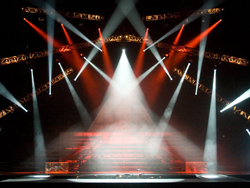The automated lighting programmer must have many skills beyond knowledge of simple programming syntax. The position requires that one evaluate each situation to determine the right method of operation. Some productions hire a programmer to handle all aspects of the lighting, while others hire a programmer to bring a lighting designer’s (LD’s) vision to life.
Real-world experience with many productions is the only way an automated lighting programmer can become successful. Knowledge, speed, accuracy, people skills, and so on are all vitally important, but there is no substitute for experience.
There are many different levels of productions, each requiring specific types of people on the production staff. Understandably, there are several different categories of automated lighting programmers. Each holds an important position within our industry, by providing different levels of experience and knowledge.
First, there is the weekend warrior. This type of person simply programs lights for fun, but has another main profession. The weekend warrior has little to no interest in learning more about the profession.
Next is the amateur programmer. Amateur programmers program lighting when and where they can (schools, churches, clubs, raves), but programming is not their main source of income. They have an interest in the profession and strive to learn more about automated lighting programming.
The apprentice programmer is involved in the lighting industry and programs whenever there is an opportunity. Oftentimes apprentice programmers are hired to work on productions in positions other than lighting programming (technician, followspot operator, etc.). They have a desire to gain as much programming experience and comprehension as possible.
A professional programmer earns his or her living by programming automated lighting. The majority of this person’s income (80–90 percent) is from programming. Automated lighting programming is the chosen career of professional programmers, and they continue to study and improve their skills as much as possible.
Finally, the professional programmer/designer works regularly as either a lighting programmer or lighting designer. Oftentimes this person will be hired onto a production filling both rolls simultaneously. The income of this professional is split between programming and design. Continued improvement of knowledge and experience is continually sought by this career type.
Of course, like most jobs in the entertainment industry, some people will work on high-profile productions (award shows, Broadway, large tours, television shows) and get lots of press. Their names will be well known in the industry and they will be mentioned in magazines and on websites.
Others will do many shows, but will not be well recognized within the industry. Yet these individuals will still be successful programmers with a grand career.
The Hollywood Syndrome
Our industry is only a small part of “show business,” yet it still lives up to many of the clichés. Many students and apprentices of the profession expect a fast track to the “big” shows. They see the concert tours roll through town and the live television broadcasts and think, “I can do that.”
Oftentimes these people will begin working with a lighting company and will not understand why they are not going out on the next big U2 or Rolling Stones tour as the programmer.
There is a good reason you see the same programmer’s names on all the big shows: experience. While anyone can learn which buttons to press on a console, it takes many years of programming to learn how to get the most out of your fixtures, work with different types of productions and LDs, and handle any situation that is thrown at you.
Ultimately, the actual data in the console is not what is important, but rather the end result. If you are able to create the LD’s vision in a timely manner and write the cue so that it is repeatable, then the methods of the data creation and storage are not essential.















